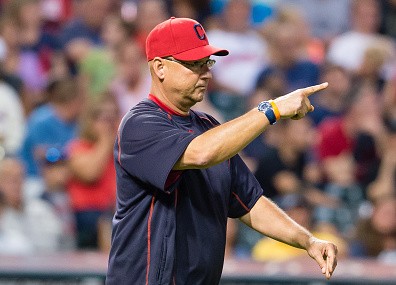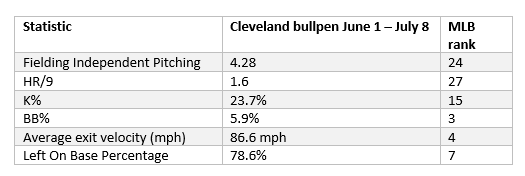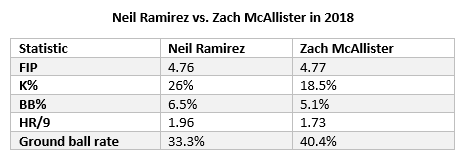As the calendar flipped to June, the Cleveland Indians’ bullpen was the biggest conversation piece among fans following the team. Unfortunately, the subject was popular for the wrong reasons: the Indians’ bullpen was probably the worst in Major League baseball.
May was a particularly bad month for Cleveland’s relievers. By WAR, they were baseball’s worst team, with a -1.4 mark for the month. The next worst team? The Mets, whose bullpen checked in nearly a full win better, at -0.5 WAR.
Including the horrific month of May, the overall numbers for Cleveland’s bullpen entering June were pretty ugly:
Whichever way you break it down, Cleveland’s relievers were awful to begin the season. The only silver lining you’ll find above is Cleveland’s league-worst LOB%. You always expect some regression towards the mean with LOB%, and most pitchers strand around 72% of their baserunners.
Cleveland’s bullpen wasn’t just ugly statistically, they were ugly anecdotally:
- Cleveland lost a game to Toronto on May 3, leading 7-5 entering the 6th inning.
- Against the Yankees on May 6, the Tribe led 4-0 going into the bottom of the 8th, but lost the game 7-4.
- The Indians lost on May 11 against Kansas City after leading 9-4
- An 8-3 lead was fumbled against Detroit on May 15.
- On May 25, the Indians led the Astros 2-0 entering the 8th inning, and managed to lose the game 11-2.
- Cleveland’s bullpen was given a 3-2 lead entering the 8th on May 27, and coughed up 6 runs. Cleveland scored 5 runs in the 9th to tie the game, and eventually won in extra innings.
By the end of the month, fans were understandably restless, and began demanding the front office make a trade to stop the bleeding. Chris Antonetti certainly wasn’t deaf to these requests, but he still wasn’t prepared to pull the the trigger on any deals. According to Antonetti, deals weren’t likely to get done until the calendar was closer to baseball’s July 31 trade deadline.
Even that was met with skepticism. Alex Colome was traded to Seattle on May 25, and Kelvin Herrera was sent from Kansas City to Washington on June 18, so clearly teams were willing to deal relievers well in advance of the deadline. Regardless, a deal wasn’t made, and still hasn’t been. It’s universally accepted that Cleveland’s bullpen could use some help at the trade deadline, but the desperation around the conversation has dissipated.
Why? If you’ve been reading about the Indians in the last month or so, you’ve surely heard the narrative that Neil Ramirez and Oliver Perez have helped turn things around for Cleveland.
To an extent, that’s true. The team’s bullpen has improved since Ramirez was signed May 15 and Perez was signed on June 2.
The impact can be seen most easily by looking at the bullpen’s numbers since June, since Ramirez only pitched 3.1 innings in May.
We can see improvement across the board compared to Cleveland’s pre-June numbers (and their subsequent MLB ranks), but it’s still a mixed bag. Certainly, the walks and average exit velocity are promising signs, but the home run and strikeout numbers paint a bleaker picture.
Looking at LOB%, we can see the positive regression we were expecting from the pre-June numbers. However, the 78.6% mark is overcompensation, and we can expect some negative regression towards 72-73% going forward.
Despite the improvement in the overall numbers, the Indians still aren’t carrying an above-average bullpen, let alone an elite one that can match the likes of New York and Houston in the playoffs.
However, the overall numbers aren’t all that matters. Due to knee issues and a DL stint, Andrew Miller (one of the best relievers in baseball when healthy) isn’t part of the sample . Meanwhile, Josh Tomlin, George Kontos, Jeff Beliveau, and Matt Belisle are all included, but almost certainly won’t be in Cleveland’s bullpen come October.
For the purpose of this article, we’re looking at the two players who supposedly helped right the ship for Cleveland’s bullpen: Neil Ramirez and Oliver Perez. Are either capable of holding down the 6th or 7th innings in the postseason?
We can first look at Perez, a nearly 37-year-old lefty who made the transition to full-time reliever in 2012 after struggling to live up to expectations as a starter. As a lefty, it isn’t surprising that Perez has performed significantly better against left-handed hitters in his time as a reliever.
It’s easy enough to see that Perez can be used as a matchup lefty, and his 2.42 FIP this season and last against lefties shows that he can still get them out, even as he enters the last stage of his career.
However, the numbers from the table also reveal he can’t be trusted against right-handed hitters, and his individual sample from last season (5.07 FIP, 1.8 HR/9) shows that this issue has become bigger as Perez has aged. Frankly, you wouldn’t want Perez near a right-handed hitter in a tight situation in the postseason.
No doubt, Perez can be useful if deployed exclusively against lefties, but he’s a far cry from a fireman, a la Andrew Miller.
Unlike Perez, Neil Ramirez is a righty who is just now finding a consistent role in the majors. He was drafted 44th overall by Texas in 2014, and was eventually traded to the Cubs in a Matt Garza trade. He impressed in his 2014 debut, putting up a 2.61 FIP, with 10.92 K/9 to 3.5 BB/9 in 43.2 relief innings.
Unfortunately, Ramirez suffered an arm injury, and bounced around until he got an opportunity with Cleveland this season.
After a watching the league’s worst bullpen in May, fans essentially fell in love with Ramirez when he didn’t allow any runs in June. To boot, he struck out 12 hitters in 12.1 innings, and only walked three hitters. In the small sample, Ramirez and his 96 mph average fastball velocity were easy to get excited about.
However, if you step back and look at a more complete picture, Ramirez becomes less exciting. Revisiting LOB%, Ramirez is currently stranding 91.5% of his baserunners, which is inflating the rest of his numbers.
Consider Ramirez’s peripheral statistics next to Zach McAllister‘s, another high-velocity righty:
Production-wise, there isn’t much to separate the two pitchers this season. Ramirez is generating more strikeouts, but he’s also issuing more walks, allowing more home runs, and inducing fewer ground balls. If you aren’t anointing McAllister as the savior of Cleveland’s bullpen, you probably shouldn’t hold Ramirez in that regard, either.
It may be true that Ramirez and Perez helped stabilize Cleveland’s bullpen. After all, Cleveland has shown improvement to their overall numbers since the two started pitching regularly. However, it’s unclear how much of the improvement was the result of (positive) regression to the mean.
The two new additions aren’t terrible bullpen options, but they certainly aren’t on the level of the Yankees and Astros third or fourth best relievers. In a world where Cody Allen and a currently injured Andrew Miller are Cleveland’s only dominant relief pitchers, the team can’t hesitate to use significant prospect capital to acquire relievers like Raisel Iglesias, Brad Hand, Richard Rodriguez, or Blake Treinen.
Add The Sports Daily to your Google News Feed!




